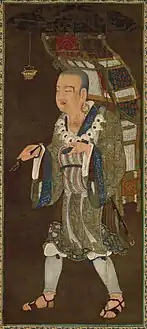تشيونتسانغ
كان تشيونتسانغ (Xuanzang) ((بالصينية: ) Sanskrit: ह्वेनसांग) (c. 596 أو 602 – 664)، المولود باسم تشن هوى (Chen Hui) ((بالصينية: )) أو تشن يى (Chen Yi) ((بالصينية: ))،[2] راهبًا بوذيًا صينيًا وعالمًا ورحالاً ومترجمًا وصف التفاعل بين الصين والهند في أوائل فترة أسرة تانغ (Tang Dynasty). وقد ولد في مقاطعة خنان (Henan) الصينية في عام 596 (أو 902، أو 603)، ومنذ وقت صباه وهو مولع بقراءة الكتب الدينية، بما في ذلك الطبقات الصينية (Chinese classics) وكتابات العصور القديمة.
| تشيونتسانغ | |
|---|---|
| (بالصينية: 玄奘) | |
 | |
| معلومات شخصية | |
| اسم الولادة | (بالصينية التقليدية: 陳禕) |
| الميلاد | 602 لويانغ |
| الوفاة | 664 تونغتشوان |
| مواطنة | سلالة تانغ الحاكمة (618–664) مملكة سوي (602–618) |
| الديانة | بوذية |
| الحياة العملية | |
| المهنة | مستكشف ، وكاتب ، ومترجم ، وراهب بوذي ، وفيلسوف |
| اللغة الأم | الصينية |
| اللغات | الصينية [1] |
وخلال إقامته بمدينة لويانغ (Luoyang)، دخل تشيونتسانغ في جماعة الرهبان البوذيين (Buddhist monkhood) في الثالثة عشرة من عمره. وبسبب الاضطرابات السياسية والاجتماعية الناجمة عن سقوط أسرة سوي (Sui Dynasty)، توجه إلى مدينة تشنغدو (Chengdu) في مقاطعة سيتشوان (Sichuan)، حيث تم تعيينه في سن العشرين. ثم سافر في وقت لاحق في أنحاء مختلفة من الصين للبحث عن كتب مقدسة للبوذية. وبعد فترة أتي إلى تشانغآن (Chang'an)، ثم تحت الحكم السلمي للإمبراطور تيزنغ من التانغ (Emperor Taizong of Tang). وهنا زادت رغبة تشيونتسانغ في زيارة الهند. لقد عرف بزيارة فاكسيان (Faxian) إلى الهند، الذي كان لديه نفس الاهتمام بالنصوص البوذية غير المكتملة والمفسّرَة بشكل خاطئ التي وصلت إلى الصين.
ولقد أصبح مشهورًا بسبب رحلته إلى الهند التي استغرقت سبعة عشر عامًا، والتي تم تسجيلها بالتفصيل في النص الصيني القديم سجلات تانغ العظمى عن المناطق الغربية (Great Tang Records on the Western Regions)، وهي بدورها قدمت إلهامًا للرواية الكلاسيكية رحلة إلى الغرب (Journey to the West)، التي كتبها وو تشنغن (Wu Cheng'en) خلال حكم أسرة منغ (Ming Dynasty)، بعد موت تشيونتسانغ بتسعة قرون تقريبًا.
انظر أيضًا
- البوذية في الصين
- نظرية الترجمة الصينية
- فاكسيان
- جينجيو سانزو|Genjō-sanzō
- سجلات تانغ العظمى عن المناطق الغربية
- هايتشو
- ابن بطوطة
- رحلة إلى الغرب
- ماركو بولو
- طريق الحرير
- انتقال البوذية عبر طريق الحرير
- العلاقات الصينية الهندية
- سون وو كونغ
- ياي جينغ (Yi Jing)
- تشانغ تشيان
- نالاندا
الحواشي
- وصلة : مُعرِّف المكتبة الوطنيَّة الفرنسيَّة (BnF) — تاريخ الاطلاع: 8 أكتوبر 2016
- There is some dispute over the Chinese character for Xuanzang's given name at birth. Historical records provide two different Chinese characters, 褘 and 禕, both are similar in writing except that the former has one more stroke than the latter. Their pronunciations in pinyin are also different: the former is pronounced as Huī while the latter is pronounced as Yī. See here and here. (Both sources are in Chinese) نسخة محفوظة 04 مارس 2016 على موقع واي باك مشين.
أعماله
- سجلات تانغ العظمى عن المناطق الغربية (Great Tang Records on the WesternRegions). 646.
- الترجمة
- Watters, Thomas (1904). On Yuan Chwang's Travels in India, 629-645 A.D. Royal Asiatic Society, London. الوسيط
|CitationClass=تم تجاهله (مساعدة)
المراجع
- Beal, Samuel (1884). Si-Yu-Ki: Buddhist Records of the Western World, by Hiuen Tsiang. 2 vols. Translated by Samuel Beal. London. 1884. Reprint: Delhi. Oriental Books Reprint Corporation. 1969.
- Beal, Samuel (1911). The Life of Hiuen-Tsiang. Translated from the Chinese of Shaman (monk) Hwui Li by Samuel Beal. London. 1911. Reprint Munshiram Manoharlal, New Delhi. 1973.
- Bernstein, Richard (2001). Ultimate Journey: Retracing the Path of an Ancient Buddhist Monk (Xuanzang) who crossed Asia in Search of Enlightenment. Alfred A. Knopf, New York. ISBN 0-375-40009-5.
- Gordon, Stewart. When Asia was the World: Traveling Merchants, Scholars, Warriors, and Monks who created the "Riches of the East" Da Capo Press, Perseus Books, 2008. ISBN 0-306-81556-7.
- Julien, Stanislas. 1857. Mémoires sur les contrées occidentales. Paris.
- Li, Rongxi (translator) (1995). A Biography of the Tripiṭaka Master of the Great Ci’en Monastery of the Great Tang Dynasty. Numata Center for Buddhist Translation and Research. Berkeley, California. ISBN 1-886439-00-1
- Li, Rongxi (translator) (1995). The Great Tang Dynasty Record of the Western Regions. Numata Center for Buddhist Translation and Research. Berkeley, California. ISBN 1-886439-02-8* Li, Yongshi, (translator) (1959). The Life of Hsuan Tsang by Huili. Chinese Buddhist Association, Beijing.
- Nattier, Jan. "The Heart Sutra: A Chinese Apocryphal Text?". Journal of the International Association of Buddhist Studies Vol. 15 Nbr. 2 (1992)
- Saran, Mishi (2005). Chasing the Monk’s Shadow: A Journey in the Footsteps of Xuanzang. Penguin Books. ISBN 978-0-14-306439-8
- Sun Shuyun (2003). Ten Thousand Miles without a Cloud (retracing Xuanzang's journeys). Harper Perennial. ISBN 0-00-712974-2
- Waley, Arthur (1952). The Real Tripitaka, and Other Pieces. London: G. Allen and Unwin.
- Watters, Thomas. On Yuan Chwang’s Travels in India Reprint. Hesperides Press, 1996. ISBN 978-1-4067-1387-9.
- Wriggins, Sally Hovey. Xuanzang: A Buddhist Pilgrim on the Silk Road. Westview Press, 1996. Revised and updated as The Silk Road Journey With Xuanzang. Westview Press, 2003. ISBN 0-8133-6599-6.
- Wriggins, Sally Hovey (2004). The Silk Road Journey with Xuanzang. Boulder, Colorado: Westview Press. ISBN 0-8133-6599-6.
- Yu, Anthony C., "Introduction" (and ed. and tran.) (1980 [1977]). The Journey to the West. Chicago and London: The University of Chicago Press. ISBN 978-0-226-97150-6
وصلات خارجية
- تشيونتسانغ على موقع Encyclopædia Britannica Online (الإنجليزية)
- تشيونتسانغ على موقع المكتبة المفتوحة (الإنجليزية)
- Details of Xuanzang's life and works
- History of San Zang A narration of Xuan Zang's journey to India.
- Xuanzang's Journey In the footsteps of Xuanzang
- 大慈恩寺三藏法师传 (全文) Chinese text of The Life of Hiuen-Tsiang, by Shaman (monk) Hwui Li (Hui Li) (沙门慧立)
| تَحتَوي هذه المقالةُ عَلى نصوص صينية؛ بدون دَعمِ تَصيِيرٍ مُناسبٍ، قَد تَظْهرُ علامات استفهام، صناديق، ورموز أخرى بدل مقاطع صينية |
- بوابة استكشاف
- بوابة البوذية
- بوابة أعلام
- بوابة الصين
- بوابة فلسفة
